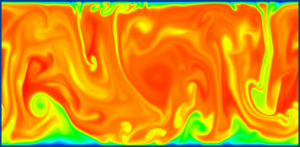White Paper: Mathematics of Turbulence
This white paper on the recent progress and remaining open questions related to IPAM’s long program Mathematics of Turbulence was written by Charlie Doering and Joe Klewicki. Read the full report.
Introduction
Turbulence is perhaps the primary paradigm of complex nonlinear multi-scale dynamics. It is ubiquitous in fluid flows and plays a major role in problems ranging from the determination of drag  coefficients and heat and mass transfer rates in engineering applications, to important dynamical processes in environmental science, ocean and atmosphere dynamics, geophysics, and astrophysics. Understanding turbulent mixing and transport of heat, mass, and momentum remains an important open challenge for 21st century physics and mathematics.
coefficients and heat and mass transfer rates in engineering applications, to important dynamical processes in environmental science, ocean and atmosphere dynamics, geophysics, and astrophysics. Understanding turbulent mixing and transport of heat, mass, and momentum remains an important open challenge for 21st century physics and mathematics.
Advances in computation and experimentation over the past two decades have yielded increasingly detailed “full field” realizations of turbulent flows, and these have been successfully exploited to advance both theoretical and applied aims. From the ever-increasing unwieldiness of these data sets alone, it is clear that future progress on the turbulence problem will increasingly depend upon on the quality of guidance provided by the underlying theoretical foundations, as well as the continued development of mathematical frameworks for analysis, prediction, optimization, and control. With these broad aims in mind, the Institute for Pure and Applied Mathematics hosted a Long Program on the Mathematics of Turbulence from September 8, 2014 through December 12, 2014. In addition to a series of tutorials presented during the first week, this long program hosted four workshops: 1) Mathematical Analysis of Turbulence, 2) Turbulent Transport and Mixing, 3) Geophysical and Astrophysical Turbulence, and 4) Turbulence in Engineering Applications.
Although each of the workshops focused on topics specific to their respective areas, as the workshop progressed a number of emergent, recurring, and cross-cutting themes became apparent. These largely pertain to the increasing toolbox of mathematical methods and theoretical concepts that are being leveraged to advance both fundamental and applied research on the mathematical properties of turbulence, as well as the prediction and control of this complex physical phenomenon. Primary among these topics are those associated with the fundamental nature of the Navier-Stokes and Euler equations and their solutions in the turbulent regime, adaptations of the mathematics of control and optimization theory for prediction and data assimilation, the development of rigorous bounds for transport properties in scalar mixing and momentum transport, and a variety of methods used in the development of reduced order models that are gaining an increasingly well-founded basis in the underlying partial differential equations. The following sections of this summary provide brief descriptions of the research directions currently being actively pursued within this broadly based research community, along with commentary pertaining to their future potential to advance mathematical approaches to the problem of fluid turbulence.





